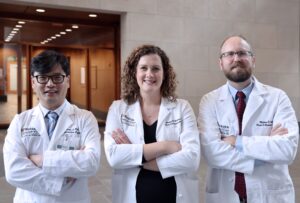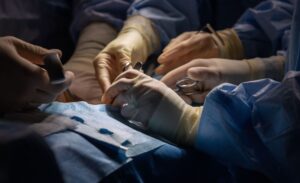Facial Paralysis
We use facial expressions to express emotions and to communicate with others. Facial paralysis, or the inability to move facial muscles, can significantly change a person’s life, affecting the ability to work, to interact with others and to achieve a sense of connection with the world. Paralysis of facial muscles can be caused by illness, by injury, as the result of surgical complications, among other causes.
To help people with facial paralysis, we offer a team of specialists who are skilled in advanced surgery techniques that can help restore facial expression. Each of these surgeons offers patients a commitment to effective communication and compassionate care while working to develop the most effective treatment plan.
Overview
There are more than 100 known causes of facial paralysis, and it can occur in anyone. Common causes in adults include traumatic injury, infection and surgery complications.
How Nerves Work
Facial expressions are controlled by the facial nerve, also called the cranial nerve VII. This nerve extends from the brain, traveling through a portion of the skull (the temporal bone) to the cheek and branching out to the other muscles in the face that make facial expressions possible.
There is one facial nerve pathway on each side of the face and five main facial nerve branches that go to the forehead, eye, cheek and nose, mouth and neck. When we want to make a specific expression—a smile, a frown—the brain sends signals through the facial nerve to activate the specific muscles in the face. Interruption anywhere along this pathway may result in facial paralysis.
Symptoms of Paralysis
There are two main categories of facial nerve malfunction: unilateral, involving one side of the face, or bilateral, affecting both sides of the face. In unilateral paralysis, a smile may cause the affected side of the mouth to be pulled to the unaffected side of the face. In bilateral paralysis, the lips may not move at all. In either type of paralysis, speech may be difficult.
A person with facial paralysis may experience eye irritation caused by abnormal function and position of the eyelids. This condition can include excess tearing, blurred vision, corneal ulcers and recurring infections. The affected eye also may appear to be larger than normal.
The paralyzed portion of the face may droop, which often is more pronounced with increased age. In unilateral paralysis, the nose may partially collapse on the affected side, making breathing more difficult.
Diagnosis
In some situations, our specialists may use specific tests to better define the cause and extent of the paralysis. These tests can provide valuable information about the type of nerve injury and may help to predict the possibility and extent of recovery.
Another test, called an electroneurography (ENOG), records the action potential of facial muscles after the facial nerve located near the base of the ear is stimulated. This test can help your specialist understand how you might respond to treatment. This test is only effective when used within the first three weeks after facial paralysis begins.
An electromyography (EMG) test can help determine the extent of nerve injury and the potential for spontaneous recovery. It can also help your specialist locate viable nerves that can be used as donor nerves in cases of multi-nerve dysfunction. This test is most effective three months after facial paralysis begins.
In some cases, an MRI imaging study may help your surgeon see the path of the affected facial nerve.
Treatment
Your specialist will work to understand the details of your particular condition. Your treatment plan will be based on the cause of your facial paralysis, its duration and the potential for improvement. Your general health will also be considered. Treatment options include: physical therapy, massage, chemodenervation using botulinum toxin (most commonly called Botox) and different types of surgeries.
Nerve and Muscle Transplant
When facial paralysis is caused by traumatic injury, the facial nerve may be significantly damaged and detached from muscle or completely absent. When treating people with this condition, our specialists may use nerve and muscle transfer surgery to reconstruct affected areas of the face.


